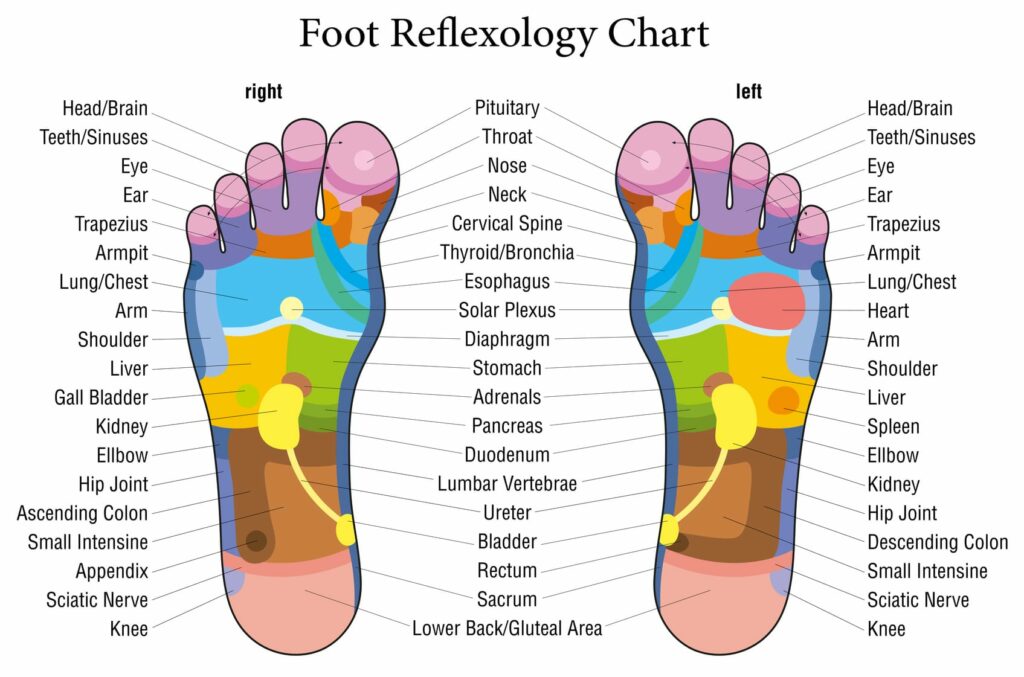
Reflexology is a technique that stimulates particular pressure points on the hands and feet to promote blood flow and reduce discomfort. It is thought that these pressure sites communicate with the body’s glands and organs directly through the nervous system. This therapy can increase the function of particular body parts and decrease pain by applying pressure to such places.
What Happens:
Naturally, your reflexology experience will be unique from everyone else’s, but the majority of individuals report feeling their bodies opening up and tingling as the energy moves through them. Your body shouldn’t feel tense after receiving reflexology. Instead, you ought to be moving in the direction of a calmer frame of mind.
You might also feel:
- Perspiration of hands or feet
- Sensation of being chilly or chilled
- The need for deep breaths
- A yearning to sleep
- the elimination of most, if not all, discomfort and suffering
- Loose, relaxed muscles
- Having the impression that your organs are unburdened by strain and stress
A therapist who has received training in the antiquated practice can provide reflexology. Additionally, it is something that may be done on yourself or a partner at home.
Before starting, you should go to a foot chart to map your condition to the proper area of your foot or feet. Then, knead the pressure point gently and thoroughly while massaging with your thumb and fingers. After 10 minutes, keep massaging the targeted area before concluding with a thorough foot massage. To seal the energy flow, take several slow, deep breaths at the conclusion of each reflexology session.
How to Use a Reflexology Foot Chart
A reflexology foot chart might be a little intimidating and perplexing when you first look at it. Don’t be deterred by it. Give it some thought and get accustomed to reading it. There is no time-sensitive aspect to practicing reflexology, other than easing your discomfort, so you can take as much time as you need to arrange your course of therapy.
You can execute a session that addresses every part of your body, or you can focus on a single ailment. Every organ, gland, and bodily component has a spot on the right or left foot that corresponds to it, as was previously explained. Simply identify that region on the foot chart if you are aware of the organs that are connected to your condition.
There is no correct or incorrect foot to begin on, and many reflexologists may focus on one particular region on one foot before switching to the other, moving on to the next location and repeating the process. Start massaging from your toes and slowly work your way down to the heel of your foot if everything else fails and you’re unsure what to do. As you go, pay close attention to the chart’s points and track how your body is responding.
The lips and teeth, the chest, and the lymph nodes are just a few of the places on the foot reflexology map that are also mapped to the tops of the feet.
HERE ARE SOME COMMON AILMENTS AND THEIR TOUCH POINTS USING REFLEXOLOGY
RELIEVE HEADACHES
Start by massaging your big toes to loosen up your neck a little as stiffness in the neck frequently results in headaches. To find the nerves leading to the head, concentrate on exerting additional pressure on the tops of each toe.
SLEEP DISORDERS
Your focus should be on the pituitary gland if you want to ease sleepless nights. Put pressure on the big toe’s middle side from the bottom up.
COLDS AND THE FLU
You should concentrate your efforts on your sinuses, nose, throat, eyes, and lungs while treating colds and the flu. The side of your big toe should catch your attention, followed by the center of each toe. Lastly, fix your attention about an inch below your toes.
DIGESTION
The digestive system is composed of several organs, most of which are located on the bottom of the foot.
both bronchitis and asthma
The lungs are the obvious target since they aid in breathing. Both the center of the top of your foot and the area just below your toes are where they are mapped.
BACK PAIN
The bottom half of each foot can be massaged to target the back, which is related to both the upper and lower bodies.
Reflexology is not a quick fix, therefore it’s vital to keep in mind that the best outcomes come from persistently focusing on a few key areas. Although it is not a miracle cure, you will eventually start to see changes in the areas where you are having problems.
Reflexology is utilized as an adjunct to conventional medical care for the majority of illnesses but is not a tool for making diagnoses. You should not use reflexology as a kind of treatment without first talking to your doctor.